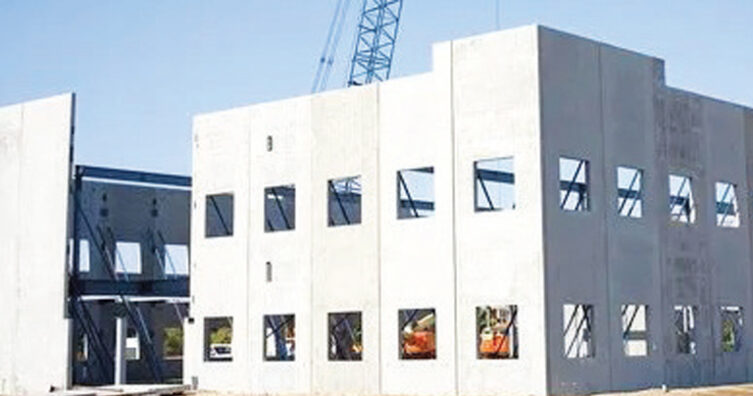Discover how steel, the cornerstone of construction, intertwines with cutting-edge methods like prefab, precast, and composites, ushering in a new era of innovation in the building industry with C A Prasad, President, Pre-engineered Society of India.
In the ever-evolving construction world, a remarkable fusion of technologies and materials has created a new era of innovation, particularly in building construction. The convergence of three construction methods—prefabrication, precasting, and composite construction—centred around the versatile steel material exemplifies this transformative trend. In this comprehensive article, we will explore these interconnected construction domains and shed light on the crucial role played by steel.
The multifaceted role of steel in construction
Prefab construction, often closely associated with steel, offers remarkable flexibility. While the Modular and Prefabricated Construction 2016 (MPC 2016) guidelines encompass various materials, steel has emerged as the preferred choice for industrial structures. The advanced attributes of steel, such as its high tensile strength and predictable performance, make it an ideal construction material, especially in industrial settings.
When considering construction materials, the usual suspects include cement, sand, timber, bricks, and more. However, steel stands out as a paragon of versatility in traditional and modern construction. Renowned for its exceptional strength and adaptability, steel has extensive application in many construction contexts, especially within the industrial sector.
Steel’s contribution to iconic architectural marvels
In India, steel construction has also gained traction, exemplified by structures such as the Millennium Tower. This towering landmark is a testament to the fusion of steel columns and beams encased in concrete, enhancing structural robustness. Despite certain drawbacks, such as susceptibility to corrosion and relatively higher initial costs, steel remains indispensable for vast industrial spaces, including warehouses, airports, stadiums, and railway stations. Here, C. A. Prasad, the President of the Pre-Engineered Society of India, gives an example, saying, “Architectural visionaries like John Iraqi and British settler architects have harnessed the potential of steel to craft iconic structures characterised by their sweeping, curvilinear designs. These awe-inspiring steel edifices adorn the European architectural landscape.” The ease with which steel can be employed in Europe, where labour costs align favourably with reinforced concrete cement (RCC), underscores its ubiquity. From bridges to stadiums, steel remains an indispensable building block in European construction.
The emergence of pre-engineered buildings (PEBs)
The concept of pre-engineered buildings (PEBs) has its roots in the pursuit of cost-effective steel structures. PEBs are meticulously designed based on bending moments, optimising steel utilisation by providing varying section depths according to structural demands. PEBs find diverse applications, ranging from industrial facilities and warehouses to commercial complexes and educational institutions. These structures offer many advantages, including aesthetic appeal, expedited construction timelines, earthquake resistance, and ease of expansion.
Augmenting fire protection for steel structures
Innovations in fire protection coatings for steel components have significantly bolstered the safety of steel structures. Two predominant types of coatings have emerged: non-reactive insulation coatings (e.g., vermiculite) and reactive intumescent coatings. Intumescent coatings, in particular, offer superlative fire resistance, expanding when exposed to high temperatures and providing robust fire protection without using false ceilings.
Composite construction: fusing the strengths of steel and concrete
Composite construction seamlessly melds steel and concrete, capitalising on steel’s strength and corrosion resistance combined with concrete’s durability. Various methods, such as encasing steel elements in concrete or employing steel tubes filled with concrete and reinforcement, enhance structural properties. Composite construction is advantageous for multi-story buildings, augmenting load-carrying capacity while maintaining slender profiles. Furthermore, it enhances fire resistance through the incorporation of fire-resistant coatings.
Precast construction: the assimilation of prefabricated elements
Precast construction entails the off-site manufacturing of building components, which are assembled on-site. Precast elements, including columns, beams, slabs, and walls, are seamlessly integrated to form sturdy structures. Precast concrete offers many benefits, including reduced construction time and enhanced quality control.
The construction industry is witnessing a harmonious convergence of prefab, precast, and composite construction methods, all with steel as the central component. Steel’s unmatched versatility, strength, and adaptability continue to shape the contemporary built environment. As we look ahead to the future, steel remains a pivotal component of innovative and sustainable construction practices, providing the foundation for iconic structures and functional spaces across the globe. This synthesis of cutting-edge construction techniques and the enduring prowess of steel underscores the industry’s commitment to progress and excellence.
Cookie Consent
We use cookies to personalize your experience. By continuing to visit this website you agree to our Terms & Conditions, Privacy Policy and Cookie Policy.


















